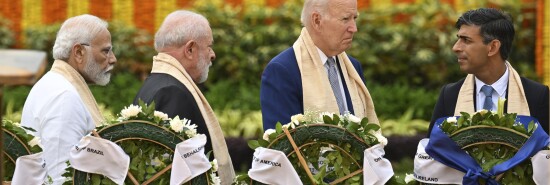
East-West crackup
Dominic Green
Video Embed
F. Scott Fitzgerald wrote that “the test of a first-rate intelligence is to hold two opposed ideas in the mind at the same time, and still retain the ability to function.” Perhaps this was true of Fitzgerald when he wrote “The Crack-Up,” his 1936 essay on how he lost the plot. Perhaps he had already lost the plot. Anyone can function while holding two opposed ideas at the same time. The easy way to do this is to deceive yourself.
The 19th G20 summit, held in New Delhi on Sept. 9 and 10, was the first time the G20 has met in India. Last year, when Indonesia held the presidency, the G20 met in Bali. Next year, Brazil is booked for the presidency. In 2025, South Africa, if it still exists by then. There are two ways to look at this sequence of locations. We can see in it the rolling victory of American-led globalization and the integration of the growing populations and economies of Asia and the Middle East into the “rules-based,” English-speaking international order. We can also see in it the recession of American influence as a new, Asian-led international order is installed on the infrastructure of the old.
REPUBLICAN THREAT BECOMES REAL FOR BIDEN AFTER IMPEACHMENT INQUIRY
The American-led world and Asian-led world are two opposed ideas. A further opposition nestles inside the idea of the Asian-led world: the rivalry of India and China. Interests can be reconciled in all kinds of ways, but that cannot compensate for shifts in the balance of economic and military power. It is not that “East is East and West is West, and never the twain shall meet.” East and West have always met for trade and war. This would be obvious to us if we studied Persia’s history as sedulously as we study Rome’s, or India’s history as keenly as we study France’s. But the terms of the encounter are changing.
The ground on which we meet has already shifted. The Atlantic Charter, the terms of the imperial handover from London to Washington, was negotiated on the USS Augusta off Newfoundland in 1941. The American order was cemented at Bretton Woods, New Hampshire, in 1944 and in the U.N. chamber in Manhattan. This geography still existed in 2008, when the G20 was founded in Washington, D.C. In the same year, the American economy collapsed. Two opposed images of America: outward expansion and inner decay. The first-rate intelligences of the Obama administration refloated the banks at the expense of the public and banked on trade with China.
In its first 10 meetings, from 2008-2014, the G20 met in the U.S. twice, the United Kingdom, Canada, South Korea, France, Mexico, Russia and Australia. Apart from Russia, which was not yet fully estranged from the American-led order, and France, which is always semi-estranged, the early G20 met on familiar and friendly soil. The nine meetings since 2015 have convened in Turkey, China, Germany, Argentina, Japan, Saudi Arabia, Italy, Indonesia, and India. Some old friends who need the American security blanket, such as Germany, Japan, and Italy, but also some enemies, such as China, frenemies, such as Turkey, Saudi Arabia, and Argentina, and unfamiliar faces, such as Indonesia and India.
The rules of the game have changed as the G20 follows the money eastward. In 2005, it cost the second Bush administration nothing to deny a U.S. visa to Narendra Modi, then the governor of Gujarat, for “severe violations of religious freedom.” American defense exports to India rose from near-zero in 2008 to $20 billion in 2020. In June, India’s order of $70 billion worth of Airbus and Boeing planes was the biggest in the history of civilian aviation. India intends to buy $100 billion worth of American weapons in the next decade. Today, Modi is feted by Congress. But when President Joe Biden flatters Modi in the hope that India will reciprocate by fighting America’s war with China, he deceives himself.
Two opposed processes are taking place at once. The Biden administration plots to buttress the old, American-made infrastructure and harness India to its anti-China strategy. But if India’s current strategy succeeds, it will harness America, the offshore power, to its drive to become an independent Asian pivot between East and West, China and America. Israel’s Benjamin Netanyahu and Saudi Arabia’s Mohammed bin Salman are also hedging their diplomatic bets as they position their countries for a future when the Middle East and India are the engine of the global economy.
The emerging Asian infrastructure is already rerouting the allegiances of America’s allies. The Belt & Road Initiative is one example. So is the rival infrastructure that was announced at the New Delhi summit. The India-Middle East-Europe Corridor, or IMEC, will link Bombay to the UAE by sea, then cross the Middle East by rail via Saudi Arabia, Jordan, and Israel. Goods will then sail from the Israeli port of Haifa to the Greek port of Piraeus, then move by rail to European markets.
The Biden administration is touting IMEC’s economic potential for the U.S., but India and the Gulf States build better roads and railroads than the U.S. does. The only American exports its allies want today are F-35s and the Sixth and Seventh fleets. Rather than extending American influence, IMEC might be a harbinger of the crack-up that happens when opposing ideas can no longer be reconciled. As Fitzgerald said, “All life is a process of breaking down.”
